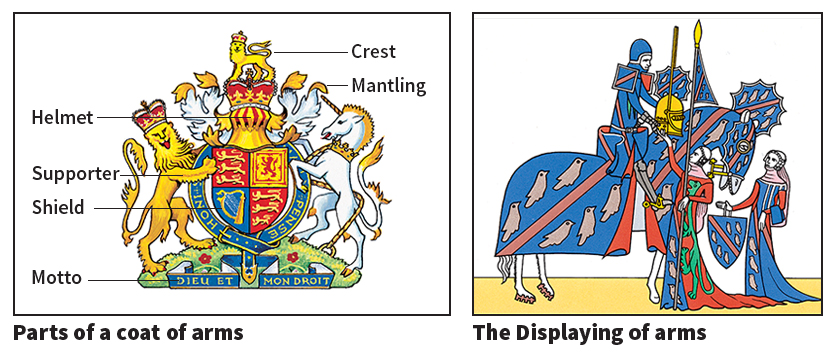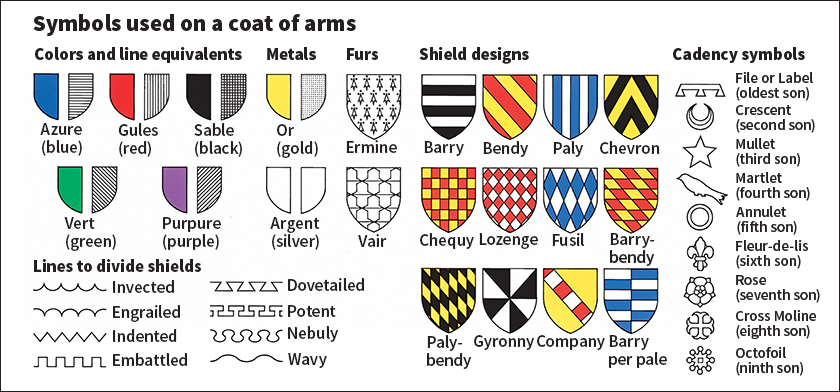Heraldry is the study of a system of symbols used to represent individuals, families, countries, and such institutions as churches and universities. The basic heraldic symbol is an emblem called a coat of arms, often known simply as arms. Coats of arms were originally used on the shields of knights.
Heraldry is related to similar systems of symbolism, such as seals and flags. It also is connected with genealogy, the study of family history.
The development of heraldry
Beginnings.
The first coats of arms appeared during the early 1100’s. They were used by Christian knights from western Europe who fought in a series of military campaigns called the Crusades. The Europeans wanted to regain control of Palestine from the Muslims. The knights wore heavy metal armor during battle, and helmets covered their faces. They displayed coats of arms on their shields and flags so their followers could recognize them on the battlefield.
Heraldry also served as a means of identification in civilian life. The upper classes in western Europe consisted of royalty, nobility, and clergy. Members of these classes identified their possessions and official documents by marking them with their coats of arms. The common people did not have coats of arms.
Expansion.
By the 1200’s, heraldry had become firmly established as a system of identification. Upper-class families passed their coats of arms down from one generation to the next. By custom, and eventually by heraldic law, no two families could use the same coat of arms. The many heraldic designs, plus the possible confusion among them, led to the development of a group of men who regulated such matters. This class consisted of official messengers called heralds.
At first, the heralds carried messages between princes and armies, announced and directed tournaments, and conducted certain ceremonies. The heralds had to know one knight from another to perform their duties, and heraldic symbols provided the necessary identification.
The duties of the heralds increased as heraldry expanded to include more and more families. For example, the heralds became responsible for keeping track of families and their coats of arms. In addition, heralds made books called armorials, in which they recorded the designs of coats of arms. They also developed a special language known as blazonry for describing the arms. In blazonry, the dexter side of a shield is the right side from the wearer’s viewpoint, and the sinister side is the left side.
The colors and the representations of metals or furs used on a coat of arms are called tinctures. They include argent (silver or white), azure (blue), gules (red), or (gold), and sable (black).
Decline.
During the 1200’s and 1300’s, European armies developed new methods of warfare that did not require the use of coats of arms. However, heraldic symbols remained important in tournaments and in some ceremonies. The emblems served as decorations at such events and showed the importance of those who used them.
Heraldry today.
Most nations have abolished heraldry and other social privileges that once belonged to the upper classes. However, some people in such countries as the United Kingdom and South Africa still use heraldic symbols to show their ancestry. In England, the College of Arms, also known as the Heralds’ College, decides who has the right to use a coat of arms. The college, established in 1484 by King Richard III, also chooses the elements that must appear on the emblem.
The governments of many nations, states, provinces, cities, and towns have coats of arms. The use of the emblems by governments is called civil heraldry. Some international organizations also have coats of arms.
In the United States, anyone may create and use a coat of arms. Such a self-created emblem is called arms of assumption. Many coats of arms for common family names are sold in the United States and Canada, but few are authentic.
Elements of a coat of arms
By the late 1400’s, heralds had established certain rules that affected the design of a coat of arms. These rules later came to be known as the laws of heraldry. The rules discussed in this article are those of England.
The basic element of any coat of arms is the shield, also known as the escutcheon. A coat of arms, sometimes called a heraldic achievement, may include certain accessories to the shield. For example, there may be a helmet above the shield and, on top of that, a crest. A cape, known as a mantling, may be attached to the helmet or draped around the shield. Many coats of arms have an accessory called a supporter on each side of the shield. Most supporters are animals or human beings.

Most coats of arms include an object or figure called a charge on the shield. Animals and plants are the most common charges, but they may not look as they do in nature. For example, a lion may be shown couped (with the tips of its head or limbs cut off). Gods, people, monsters, and certain lifeless objects are also used as charges. The shield and all accessories stand on a base, known as the compartment, or above a motto, which is called the device.

A family’s coat of arms may indicate the cadency (status) of individual members or of different branches of the family. Symbols called marks of cadency designate these family relationships. For example, each son in a family uses a different, personal symbol to show his order of birth.
